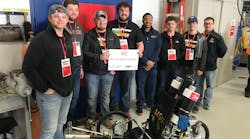The challenge for the judges in the 2018 Fluid Power Vehicle Challenge Competition seemed almost as daunting as that faced by the 10 university engineering student teams they’d be judging. These students were to redesign a traditional bicycle using hydraulics as the mode of power transmission. The teams, sponsored by Danfoss Power Solutions in Ames, Iowa, were judged on several criteria, including design objectives, the vehicle design itself, fluid power circuit design, hardware selected to support design criteria, objective analyses and resulting corrections, prototyping, and final presentation.
For many of the students who participated, this was their first experience with fluid power. The judges agreed—all competitors showed creativity, innovation, and the ability to apply these gifts while learning about this technology.
As difficult as the judges’ jobs were, there were three strong winners:
1st place: Murray State University
2nd place: Cleveland State University
3rd place: Milwaukee School of Engineering
The objective of the first-place Murray State team: “To create a vehicle that can store hydraulic energy and release on demand while also being able to incorporate regenerative braking.”
Alongside the top three winners, the other teams proved their excellence in a variety of other Bests:
- Presentation: Milwaukee School of Engineering;
- Best Teamwork: West Virginia University;
- Best Workmanship: Western Michigan University;
- Best Reliability and Safety: Purdue;
- Outstanding Achievement: Western Michigan University;
- Sprint Race: Murray State University;
- Efficiency Challenge: Murray State University;
- Endurance Challenge: Milwaukee School of Engineering.
Besides Danfoss, the competition’s host for the second year in a row, other National Fluid Power Association (NFPA) member sponsors included SunSource and Eaton (the parts suppliers), Lube-Tech (the fluids suppliers), and Parker Hannifin, offering overall support for the competition.
For information on supporting next year’s event, or if you would like to get your local university to participate, contact Lynn Beyer at (414) 778-3364 or [email protected].


